EuroVelo development improves, but not as fast as it should to meet 2030 targets!
It is no small task to analyse and try to make sense of the yearly progress in development levels of a 92,820-km network comprising 17 routes that cross 38 countries. Detailed data needs to be collected from national partners, which works well in the 23 countries with National EuroVelo Coordination Centres (NECCs) in place, but can prove more challenging in the 15 remaining ones(1).
Let’s dive in the data!
Two-thirds of the network developed & positive increase in development levels
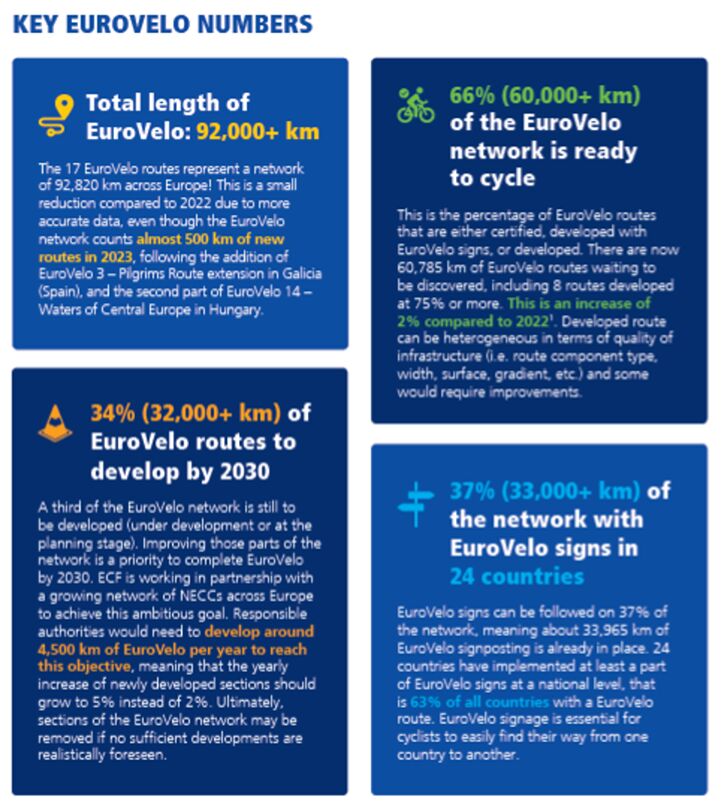
Analyses presented in the EuroVelo Route Development Status Report 2022-2023 (third edition) indicate that over a third of the network is developed with EuroVelo signs, which exist in 24 countries out of 38, and a fourth is developed with national signage, including 8 routes developed at 75% or more. Only 2% of the European cycle route network is certified according to the European Certification Standard (ECS), corresponding to EuroVelo 15 – Rhine Cycle Route.
ECS Certification requires a thorough analysis of precise survey data and has not been conducted in many parts of the network yet. All other development status categories are shared by National EuroVelo Coordination Centres (NECCs) or other local partners based on their knowledge of the route quality. A EuroVelo route section is called “developed” when it is ready to cycle, but developed routes are heterogeneous in terms of infrastructure: they can contain sections with various types of route components, traffic volumes, surface, width, gradients, etc.
It is interesting to note that three of the top five routes in terms of levels of development have ongoing EuroVelo Route Partnerships (EuroVelo 15, EuroVelo 19 and EuroVelo 1), while four out of the top five countries have well-structured NECCs and are involved in at least one EuroVelo Route Partnership (Switzerland, France, Belgium and Ireland).
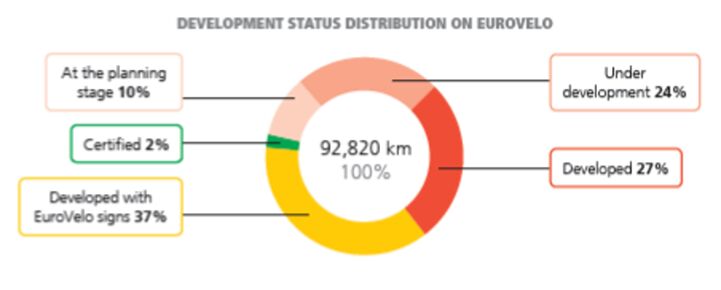
This year’s report includes more good news with the 11% increase in the development of EuroVelo 5 – Via Romea (Francigena), mostly connected to improvements of the Italian sections, and increases of over 5% in the development levels of Greek, Hungarian and Italian national networks. In particular, Greece now counts its first 83 km of EuroVelo being developed, representing 6% at a national scale – a good example to follow for the 10 other countries without any developed EuroVelo sections yet. In turn, Hungary counts 382 km of newly developed sections, including the second part of EuroVelo 14 – Waters of Central Europe, newly added to the network.
If you are curious to know how your country is performing in terms of EuroVelo development and to know the exact levels of development per country and route, head over to the complete report!
More investments needed to complete EuroVelo by 2030
Responsible authorities would need to develop around 4,500 km of EuroVelo routes per year to complete the network by 2030, meaning that the yearly increase in newly developed sections should grow by 5% instead of 2%. Moreover, it is essential to complete EuroVelo signage for the network to be visible and the routes to be easy to follow. As the map below highlights, EuroVelo signage is still missing in 14 countries and covers less than 50% of the network in 9 countries.
Additionally, the current data does not include information on the quality of the infrastructure, except for the 2% of certified routes. We need more investments in the collection of survey data and the harmonisation of existing data standards in order to estimate, and improve, the quality of the infrastructure across the EuroVelo network.
Ultimately, sections of the EuroVelo network may be removed if no sufficient developments are realistically foreseen.
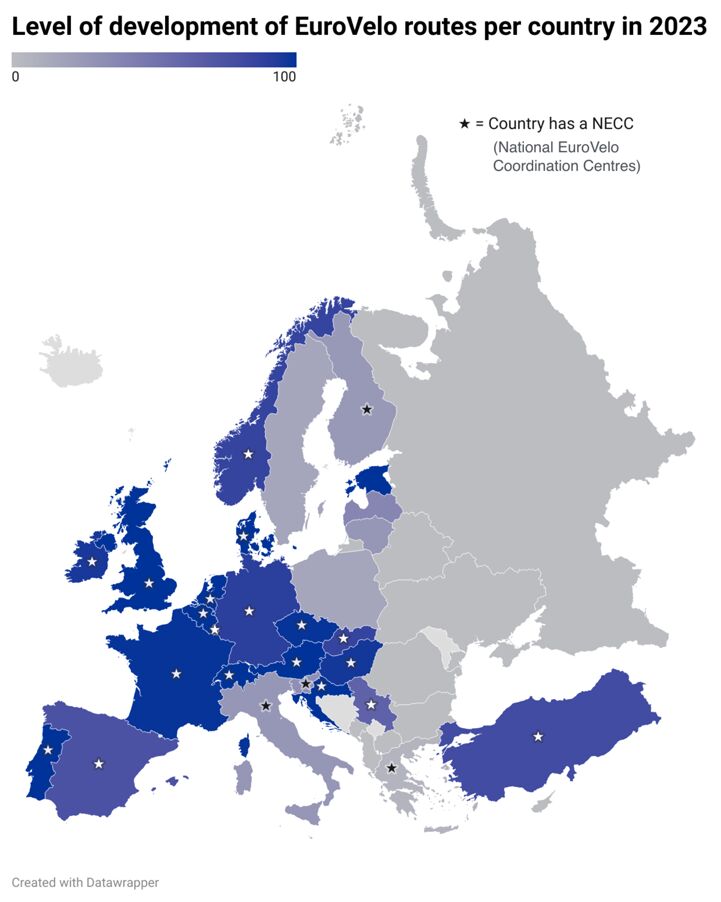
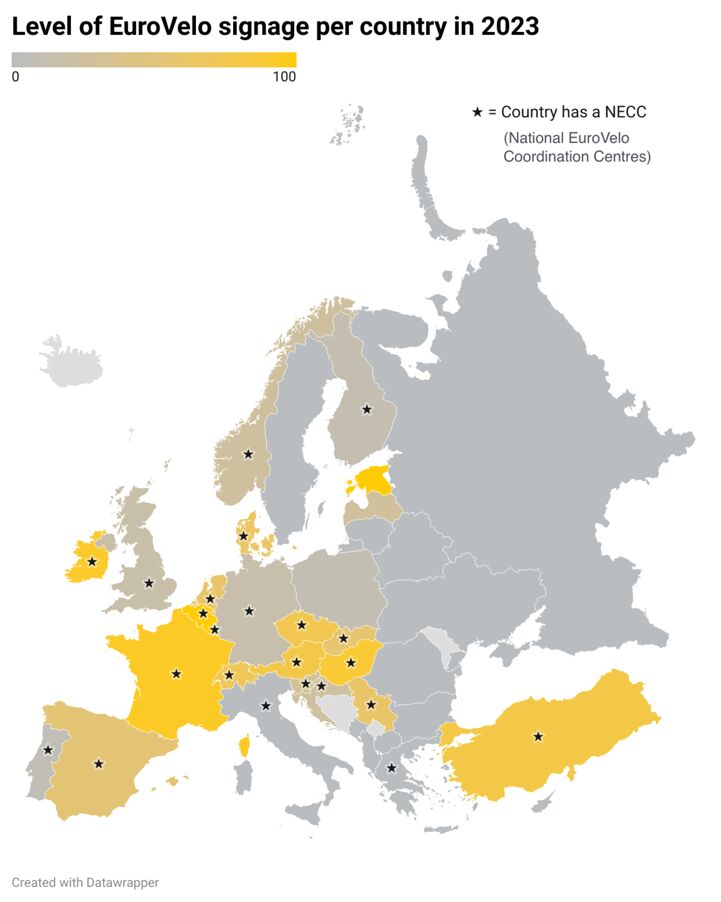
Backing analyses with precise survey data for more accurate EuroVelo development rates
Conceiving such a report is not an easy task. Apart from gathering and analysing data, the data itself needs to be harmonised and sometimes corrected to improve the EuroVelo database accuracy. That was the case this year: corrections were made to existing EuroVelo data in a few countries to better reflect their levels of development. This type of progress does not appear in the evolution rankings and can even make the overall country’s development rate decrease, but it should nevertheless be celebrated as a positive development as it improves our knowledge of the network.
Despite the challenges and occasional errors, we are convinced that it is essential to extract detailed figures on the EuroVelo routes’ levels of development and track their progress from year to year if we are to reach our goal: a fully ready-to-cycle EuroVelo network by 2030. Going forward, we are asking ourselves how to improve the accuracy and thoroughness of data communicated to the users and the network’s development statistics.
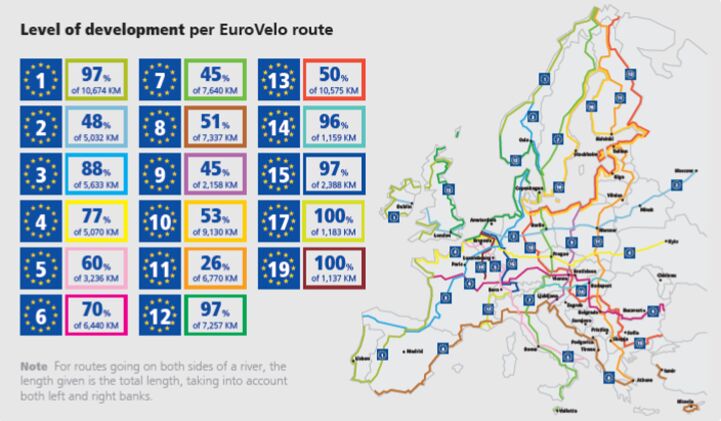
ECF has developed a comprehensive methodology to assess the quality of cycle routes, called the European Certification Standard (ECS). It can be used to survey and assess the quality of European/national/regional routes, and to certify EuroVelo routes if the criteria are met. Provided that detailed survey data on a EuroVelo route section is available in the right format, ECS would allow to assign it a level of development according to well-defined criteria applicable at the European scale and taking quality into consideration.
The ECS methodology could be used to update the current development level categories and better reflect the conditions for cyclists in communications tools and in the annual EuroVelo Route Development Status Report. To do that, ECF will need to gather precise survey data, collected through ECS tools or imported into the EuroVelo database (for context, a bit less than a fourth of the network is available with survey data at the moment).
New EuroVelo categories are being discussed amongst NECC GIS experts in 2023 and the EuroVelo management team is trying to collect more and more survey data to improve the quality of the information provided to users and partners. We hope that the ongoing work will be reflected in next year’s report.
Looking at the report with a broader perspective
The findings included in the EuroVelo Route Development Status Report are clear: a stronger push for infrastructure and route development is needed in order to meet the 2030 target. They also highlight the importance of the advocacy work done by ECF to push for more investments in cycling infrastructure and to help countries access EU funds for cycling investments.
Integrating EuroVelo into the Trans-European Transport Network (TEN-T) would also greatly accelerate network improvements by encouraging synergies between the two networks and the inclusion of cycling infrastructure on major transport corridors, which can otherwise create barriers for walking and cycling. A detailed analysis showed that EuroVelo connects with the TEN-T network nearly 8,000 times – overlapping sections representing more than 10% of the EuroVelo network – which confirms the wide scope of this work. In the ongoing revision process, the European Parliament proposed to take synergies with EuroVelo on board in article 5 of the TEN-T guidelines, but the Council of the EU General Approach did not include a similar provision. As of September 2023, the final shape of the revised regulation is still a subject of negotiations between European institutions.
Article by Florence Grégoire, with contributions from Agathe Daudibon and Jessica Casagrande
(1) If you are from a country missing an NECC and you would like to create one, please do not hesitate to get in touch with us and check the dedicated page with more info!